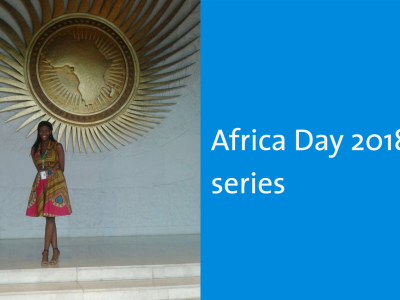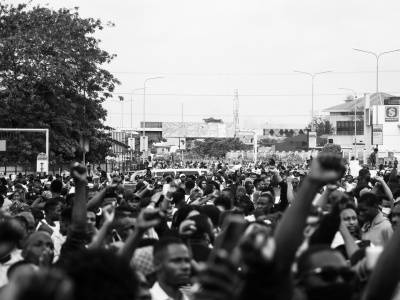
Time for leaders and youth to shape the Africa they want, together
Without a united collective voice that might at least provide a coherent message on behalf of the youth, there is limited pressure on leaders to engage beyond rhetoric.
Youth unemployment in Africa is a much more serious problem than climate change and ought to be dealt with urgently.
These were the strong sentiments uttered by Professor Emmanuel Nnadozie, Executive Secretary of the Africa Capacity Building Foundation, during the 5th Africa Think Tanks Summit held at the beginning of this month in Accra, in Ghana. The event focused on the challenge of youth unemployment in Africa, and what think tanks could do to help address it.
This was just one more in a series of recent events that have signalled the urgency of the problem. The discussions at the Organisation for Economic Co-operation and Development’s Global Forum on Development centred around ‘youth’ and ‘women’, while at the Multinational Development Policy Dialogue of the Konrad-Adenauer Stiftung and the Embassy of Nigeria in Brussels, last week, the main concern was how to enhance youth employability and inclusive growth in Nigeria.
All these events shared the wish to find ‘best fit’ solutions to a common problem: how to address the enormous challenge of mainstreaming youth in development processes successfully, towards achieving the central goal of the 2030 Agenda to “leave no one behind”.
Youth unemployment is a global challenge, but Africa seems to be worst affected. As part of his remarks, Professor Nnadozie noted:
There is practically no African country that doesn’t have this as their number one challenge.
He was citing a publication by the African Development Bank on jobs for youth in Africa, which highlights that one-third of the African youth between 15 and 35 is unemployed and discouraged and another one-third is employed in vulnerable conditions, meaning informally and with a very low wage.
This represents a worrying situation that, if ignored, will end up further marginalising Africa’s youth from socio-economic development processes, posing serious risks to peace and security as shown by the rising number of young people who are being recruited by radical extremist groups, and recent protests in some countries.
Rhetorics and actions from the top
African leaders acknowledge the urgent need to address the educational, economic and political exclusion that the youth are facing. Paul Kagame, President of Rwanda, said:
Tens of thousands of young African bodies have been swallowed by the sea or abandoned in the desert, in pursuit of a decent life for which they are prepared to risk everything because they believe there is no hope at home. They testify to the urgent need to act.
In her opening remarks, the Ambassador of Nigeria to Belgium, H.E. Nonye Udo, placed quality education that is “fit for purpose” at the core of addressing this problem, as many speakers remarked, the problem of youth unemployment in Africa is the misalignment of what is supplied in the curricula and the demands of the market – this urgent need for education reform in Africa has repeatedly been shared by former president of Tanzania H.E. Jakaya Kikwete.
Equally, diversifying African economies is necessary and governments must facilitate a conducive environment for private investors to do business and create the much-needed jobs. Public-private partnerships were highlighted for their crucial role in addressing infrastructure gaps that hinder the ease of doing business. Recognising the informal sector (which is the largest employer of youth and women in most African countries) by facilitating access to financing for small and medium enterprises is also necessary for job creation.
It must be noted that, however, the rising rhetoric to address this problem builds on numerous existing regional frameworks in Africa that target youth development.
The Africa Youth Charter is strategic in guiding member states on how to address youth empowerment and development at continental, regional and national levels. It includes articles covering rights, freedoms and responsibilities of the African youth, it has been signed by 42 member states and ratified by 38 as of March 2016.
Other important initiatives include the African Youth Decade Plan of Action and the Technical and Vocational Education and Training Continental Strategy. Aspiration number six of Agenda 2063 also speaks of “an Africa whose development is people-driven, relying on the potential of African people, especially its women and youth, and caring for children”. At the national level, 32 African countries have a youth policy in place.
All these frameworks propose steps to empower young people to play a meaningful role as equal partners in the development process. The African Youth Decade Plan of Action, in particular, gives detailed guidance about the legislation, policies, programmes, and the actors, as well as institutional capacity building and resource mobilisation. It also underlines specific time frames to achieve the desired outcomes. Unfortunately, as promising as all these pledges sound, they suffer from lack of implementation.
Actions (or lack thereof) from the bottom
One of the big implementation challenges stems from the disorganisation of the African youth themselves. There does not seem to be effective coordination of different youth organisations on the continent either at the national or regional level. National youth councils have been accused of being exclusive and at times overly political, while some do not function at all.
At the continental level, the Pan African Youth Union has suffered from the same accusations of non-inclusivity and recently came under heavy criticism for irregularities in their electoral process during its 5th congress last December. Following the vote, the African Union released a statement dissociating itself from the results, stating non-recognition of its current executive committee.
The fragmentation and weakness of youth bodies in Africa (in contrast to women’s movements, for instance) undermines the cause of furthering youth development on the continent as there is no collective voice that might at least provide a coherent message on behalf of the youth, hence limited pressure on leaders to engage beyond the rhetoric.
The need to align commitments and stick to them
This is not to say that nothing is happening anywhere. Countries like Kenya and Morocco have set quotas for youth representation in their national parliaments, and Botswana recently appointed a 31-year old young woman as the Minister of investment, trade and industry – all positive steps in the right direction that might be emulated by other African countries. The AU’s African Youth Decade Plan of Action recommends that African countries commit a fixed percentage of national budgets towards youth development. An important commitment, which would need to be backed by a strong review mechanism at the regional level to guarantee that each member state respects it in practice.
The #NotTooYoungToRun campaign in Nigeria serves as a good example of what could be achieved through proper coordination. The youth movement managed to secure the passage of a bill for age reduction to run for political office by both National and State Houses of Assembly, the bill is currently awaiting Presidential approval.Young people can learn a lot from this.
Rwanda’s gender budgeting efforts might also teach some valuable lessons in this regard. Borrowing from the country’s example, a youth budgeting framework could be put in place with ministries and their departments encouraged to have specific goals for youth empowerment within a specific timeframe. As in Rwanda, this could be reinforced by a youth monitoring office that would be in charge of evaluating outcomes and hold ministries accountable for delivering on their youth-related objectives.
A crucial part of Rwanda’s initiative has been engaging civil society and the research community in providing feedback to the government on how to strengthen their programmes, and this is where actors such as youth organisations might come in. If youth movements could get their act together and organise properly, they might be able to apply political pressure for similar processes.
Of course, the buck stops with the leaders and it is up to them to go beyond rhetoric and finally invest in their youth. But young people need to realise that they too, have a responsibility.
When tomorrow comes, they will need to be well armed with the right skills and experience to lead the continent forward and give shape to the Africa they want, as Agenda 2063 puts it.
Looking ahead, one hopes that, when their time comes, the African youth will lead better than their predecessors and not succumb to political infighting and create the right opportunities for the next generations.
The views expressed are those of the author and not necessarily those of ECDPM.



